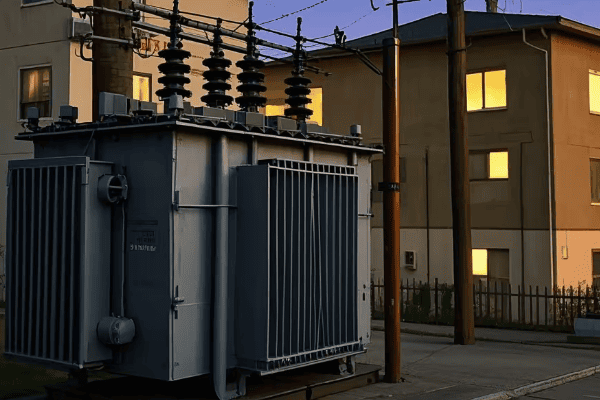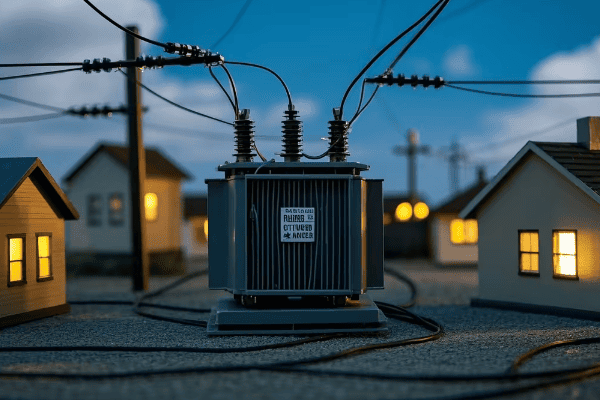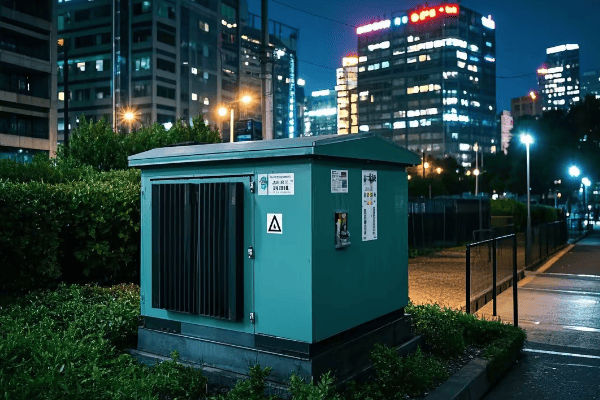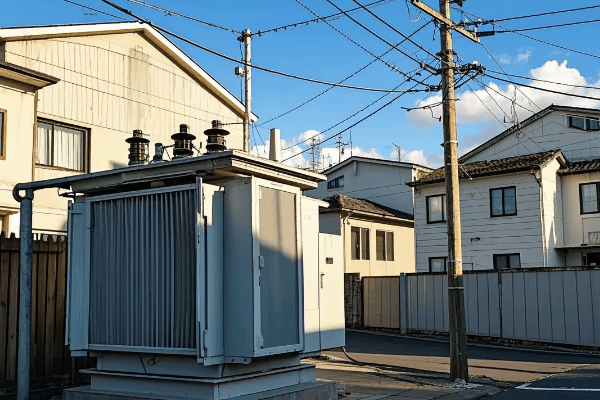Power Transformer and Distribution Transformer: The Dual Pillars of Electrical Grid Efficiency?
Have you ever wondered how electricity travels from power plants to your home? It’s a journey that involves two unsung heroes: power transformers and distribution transformers.
Power transformers and distribution transformers are the backbone of our electrical grid. They work together to ensure efficient power transmission and distribution, making it possible for us to enjoy reliable electricity in our daily lives.

As an electrical engineer with years of experience in the power industry, I’ve seen firsthand how crucial these transformers are. Let’s dive deeper into their roles and why they’re so important for our modern electrical systems.
What Sets Power Transformers Apart from Distribution Transformers in Grid Operations?
Picture this: a massive power plant generating electricity, but how does that power reach your neighborhood? That’s where power transformers and distribution transformers come into play.
Power transformers handle high voltages at power plants and substations, while distribution transformers lower the voltage for safe use in homes and businesses. They differ in size, capacity, and placement within the electrical grid.

Let’s break down the key differences between these two types of transformers:
Size and Capacity
Power transformers are the giants of the transformer world. I remember the first time I saw one up close – it was as big as a small house! They’re designed to handle enormous amounts of power, often in the range of hundreds of megavolt-amperes (MVA).
Distribution transformers, on the other hand, are much smaller. You’ve probably seen them mounted on utility poles or in green boxes in your neighborhood. They typically handle power in the range of 5 to 500 kVA.
Voltage Levels
Here’s where the real magic happens:
| Transformer Type | Input Voltage | Output Voltage |
|---|---|---|
| Power Transformer | 100kV – 1000kV | 20kV – 100kV |
| Distribution Transformer | 4kV – 35kV | 120V – 600V |
Power transformers work with extremely high voltages, stepping them down for long-distance transmission. Distribution transformers take that stepped-down voltage and reduce it further to levels safe for household use.
Location in the Grid
Power transformers are found at power plants and major substations. They’re the first step in the journey of electricity from generation to consumption.
Distribution transformers are the last step before power reaches the end-user. You’ll find them closer to residential and commercial areas.
Efficiency and Losses
Both types of transformers strive for high efficiency, but power transformers generally have higher efficiency ratings due to their larger size and the critical nature of their role. Even a small improvement in efficiency can result in significant energy savings given the large amounts of power they handle.
Distribution transformers, while also efficient, may have slightly lower efficiency ratings. However, their efficiency is crucial too, as losses at this stage directly affect the end-user’s power quality and electricity costs.
How Do Power and Distribution Transformers Synergize to Enhance Grid Performance?
Imagine an orchestra where each instrument plays its part perfectly, but they’re not in sync. The result would be chaos, not music. The same principle applies to our electrical grid.
Power and distribution transformers work in harmony to ensure efficient power transmission. Power transformers step up voltage for long-distance transmission, while distribution transformers step it down for local use, minimizing energy losses and ensuring stable power supply.

Let’s explore how these two types of transformers work together:
The Power Journey
- Generation: At the power plant, electricity is generated at relatively low voltages.
- Step-Up: Power transformers increase this voltage to very high levels (often 400kV or more) for efficient long-distance transmission.
- Transmission: High-voltage power travels through transmission lines, minimizing losses over long distances.
- Step-Down: At substations, power transformers reduce the voltage to medium levels (typically 33kV or 11kV).
- Distribution: Distribution transformers further reduce the voltage to levels suitable for homes and businesses (120V/240V in the US).
Balancing Act
The synergy between power and distribution transformers is all about balance. Power transformers handle the bulk power transfer, while distribution transformers manage the final delivery. This division of labor ensures that each type of transformer can be optimized for its specific role.
Load Management
Distribution transformers play a crucial role in load management. They’re designed to handle the varying power demands of local areas throughout the day. Power transformers, meanwhile, ensure that there’s always enough power available to meet these changing demands.
Fault Protection
Both types of transformers incorporate protective measures, but they work together to isolate faults and prevent widespread outages. A fault at the distribution level can be isolated without affecting the entire grid, thanks to this hierarchical system.
Efficiency Optimization
By working in tandem, power and distribution transformers optimize the overall efficiency of the grid. The high voltages used in transmission (thanks to power transformers) minimize line losses, while the lower voltages at the distribution level (courtesy of distribution transformers) ensure safe and efficient power use by consumers.
The Impact of Power and Distribution Transformers on Energy Efficiency: A Detailed Analysis
As an engineer, I’m always excited about efficiency. It’s not just about saving money – it’s about making the most of our resources and reducing our environmental impact.
Power and distribution transformers significantly impact energy efficiency by minimizing transmission losses and optimizing voltage levels. Their combined efficiency determines how much of the generated power actually reaches end-users, directly affecting energy costs and environmental impact.

Let’s dive into the numbers and see how these transformers affect energy efficiency:
Efficiency Ratings
Transformer efficiency is typically very high, but even small improvements can have a big impact:
| Transformer Type | Typical Efficiency |
|---|---|
| Power Transformer | 99.5% – 99.9% |
| Distribution Transformer | 98% – 99% |
These might seem like small differences, but when you’re dealing with massive amounts of power, every fraction of a percent counts.
Losses in Transformers
Transformers experience two main types of losses:
- No-load losses: These occur even when the transformer is energized but not supplying load. They’re mainly due to the magnetization of the core.
- Load losses: These increase with the load and are primarily due to resistance in the windings.
Power transformers, due to their size and continuous operation, focus more on minimizing no-load losses. Distribution transformers, with their varying loads, need to balance both types of losses.
Impact on Grid Efficiency
Let’s consider a simplified example:
- A power plant generates 100 MW of power.
- It passes through a power transformer (99.7% efficient) for transmission.
- At the substation, it goes through another power transformer (99.7% efficient).
- Finally, it passes through a distribution transformer (98.5% efficient) to reach homes.
The total efficiency would be: 0.997 0.997 0.985 = 0.979 or 97.9%
This means that out of the 100 MW generated, only about 97.9 MW reaches the end-users. The 2.1 MW lost is enough to power thousands of homes!
Economic and Environmental Impact
The efficiency of transformers has a direct impact on:
- Energy Costs: Higher efficiency means less power needs to be generated to meet demand, reducing fuel costs and potentially lowering electricity prices for consumers.
- Carbon Emissions: Improved efficiency reduces the amount of fuel burned for power generation, directly lowering carbon emissions.
- Grid Stability: Efficient transformers help maintain voltage stability, reducing the risk of power quality issues and outages.
Regulatory Push for Efficiency
Recognizing the importance of transformer efficiency, many countries have implemented minimum efficiency standards. For example, the U.S. Department of Energy’s standards for distribution transformers are expected to save 3.63 quads of energy over 30 years – that’s equivalent to the annual energy use of 27 million homes!
Smart Grid Integration: The Evolution of Power and Distribution Transformer Technologies
The term "smart grid" used to sound like science fiction to me. Now, it’s becoming a reality, and transformers are at the heart of this revolution.
Smart grid integration is transforming power and distribution transformers into intelligent, communicative devices. These advanced transformers can monitor their own health, adjust to changing loads, and communicate with other grid components, enhancing overall grid efficiency and reliability.

Let’s explore how transformer technology is evolving to support smart grids:
Smart Features in Modern Transformers
-
Real-time Monitoring: Advanced sensors in transformers can now monitor:
- Oil temperature
- Winding temperature
- Load current
- Voltage levels
- Dissolved gas content
-
Data Analytics: This data is processed to:
- Predict potential failures
- Optimize load distribution
- Schedule maintenance
-
Communication Capabilities: Transformers can now communicate with control centers, allowing for:
- Remote monitoring
- Automatic alerts
- Integration with other smart grid components
-
Adaptive Features: Some advanced transformers can:
- Automatically adjust voltage levels
- Respond to changes in power quality
- Self-diagnose issues
Benefits of Smart Transformer Technology
-
Improved Reliability: By predicting and preventing failures, smart transformers can significantly reduce outages.
-
Enhanced Efficiency: Real-time load management and voltage optimization lead to reduced losses.
-
Extended Lifespan: Predictive maintenance helps extend the life of transformers, reducing replacement costs.
-
Better Integration of Renewable Energy: Smart transformers can help manage the variable nature of renewable energy sources.
-
Faster Outage Response: When issues do occur, smart transformers can pinpoint the problem, allowing for faster repairs.
Challenges in Smart Grid Integration
While the benefits are clear, there are challenges to overcome:
-
Cost: Smart transformers are more expensive than traditional ones. The challenge is justifying this cost against long-term benefits.
-
Cybersecurity: With increased connectivity comes increased vulnerability to cyber attacks. Robust security measures are crucial.
-
Data Management: The sheer volume of data generated by smart transformers requires advanced data management and analysis systems.
-
Standardization: For a truly integrated smart grid, we need standardized communication protocols across different manufacturers and systems.
Future Prospects
The future of transformer technology in smart grids is exciting. Some areas of development include:
-
AI Integration: Using artificial intelligence for more advanced predictive maintenance and grid optimization.
-
Solid-State Transformers: These could offer even more flexibility and control in power distribution.
-
Energy Storage Integration: Combining transformers with energy storage systems for better load balancing and renewable energy integration.
-
Self-Healing Grids: Advanced transformers could play a key role in creating grids that can automatically detect, isolate, and repair faults.
Maintenance Strategies for Power and Distribution Transformers: Ensuring Long-term Grid Reliability
In my years working with transformers, I’ve learned one crucial lesson: proper maintenance is not just about preventing failures – it’s about ensuring the long-term health of our entire power grid.
Effective maintenance of power and distribution transformers is crucial for grid reliability. Strategies include regular inspections, oil analysis, thermal imaging, and predictive maintenance techniques. These practices extend transformer life, prevent unexpected failures, and ensure consistent power quality.

Let’s explore the key maintenance strategies for both power and distribution transformers:
Regular Inspections
-
Visual Inspections:
- Frequency: Monthly for power transformers, quarterly for distribution transformers
- Check for: Oil leaks, rust, damaged bushings, unusual sounds
-
Thermal Imaging:
- Frequency: Annually
- Purpose: Detect hot spots that could indicate problems
-
Acoustic Emissions Testing:
- Frequency: Annually for critical transformers
- Purpose: Detect partial discharges and other internal issues
Oil Analysis
Oil is the lifeblood of a transformer. Regular analysis can reveal a lot about a transformer’s health:
-
Dissolved Gas Analysis (DGA):
- Frequency: Annually for power transformers, every 3-5 years for distribution transformers
- Purpose: Detect internal faults, overheating, and insulation breakdown
-
Oil Quality Tests:
- Frequency: Annually
- Check for: Acidity, moisture content, dielectric strength
-
Furan Analysis:
- Frequency: Every 3-5 years
- Purpose: Assess the condition of paper insulation
Electrical Testing
-
Insulation Resistance Test:
- Frequency: Annually
- Purpose: Check the condition of insulation
-
Power Factor Testing:
- Frequency: Every 3-5 years
- Purpose: Detect deterioration in insulation
-
Turns Ratio Test:
- Frequency: During commissioning and after any suspected impact
- Purpose: Verify the transformer’s turns ratio
Predictive Maintenance Techniques
-
Online Monitoring Systems:
- Continuous monitoring of key parameters
- Real-time alerts for abnormal conditions
-
Data Analytics:
- Use historical data to predict potential failures
- Optimize maintenance schedules
-
Condition-Based Maintenance:
- Schedule maintenance based on actual condition rather than fixed intervals
Maintenance Challenges and Solutions
-
Aging Infrastructure:
- Challenge: Many transformers are nearing the end of their designed lifespan
- Solution: Life extension programs, strategic replacement planning
-
Skill Gap:
- Challenge: Shortage of experienced maintenance personnel
- Solution: Training programs, knowledge transfer from retiring experts
-
Balancing Cost and Reliability:
- Challenge: Justifying maintenance costs
- Solution: Risk-based maintenance strategies, demonstrating long-term cost savings
-
Environmental Concerns:
- Challenge: Handling of transformer oil, PCB contamination in older units
- Solution: Use of environmentally friendly oils, proper disposal procedures
Best Practices for Transformer Maintenance
-
Develop a Comprehensive Maintenance Plan: Tailor plans to each transformer’s criticality and condition.
-
Implement a Robust Record-Keeping System: Track all maintenance activities and test results.
-
Invest in Training: Ensure maintenance personnel are up-to-date with the latest techniques and safety procedures.
-
Utilize Technology: Implement online monitoring and data analytics for more efficient maintenance.
-
Regular Review and Update: Continuously assess and improve maintenance strategies based on outcomes and new technologies.
Conclusion
Power and distribution transformers are indeed the unsung heroes of our electrical grid. Their efficient operation and proper maintenance are crucial for the reliable power supply we often take for granted. As we move towards smarter, more efficient grids, the role of these transformers will only become more important.
Free CHBEB Transformer Catalog Download
Get the full range of CHBEB transformers in one catalog.
Includes oil-immersed, dry-type, pad-mounted, and custom solutions.
Quick Message
Request A free quote
We'd like to work with you
- +86 15558785111
- [email protected]
- +86 15558785111
What We Do
CHINA BEI ER BIAN (CHBEB) GROUP, with 218 million in registered capital, originated from Beijing Beierbian Transformer Group. Headquartered in Beijing for R&D, it operates major production bases in Nanjing and Yueqing, producing high-quality products.
Latest Product
address
BeiJing
No 3,RongJing East Road,BeiJing Economic Technological Development Area,BeiJing,China
JiangSu
No 7️Xiangfeng Road,Jiangning,NanJing,JiangSu,China
WenZhou
No.211, Wei 16 Road, Industrial Zone, Yueqing, Wenzhou, Zhejiang, China.
XiangYang Industrial Zone ,YueQing,WenZhou,ZheJiang,China
contact us
- [email protected]
- +86 13057780111
- +86 13057780111
- +86 15558785111
Copyright © Bei Er Bian Group


